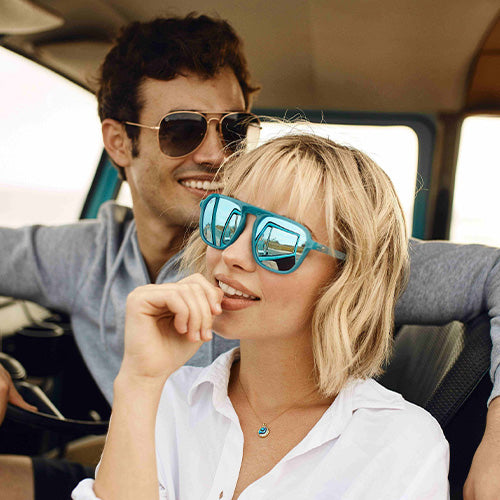They reduce glare. Seems simple enough. But the way polarized glasses reduce glare, and when and where you may wish to have this popular feature, gets more involved. And more interesting. Let’s delve in!

WHAT GLARE DO POLARIZED LENSES REDUCE?
Glare exists in a host of outdoor environments. Just about anywhere you find horizontal surfaces, you have light that hits these surfaces and scatters as it reflects. Why should you care about that? These scattered light beams often overwhelm the eyes. They affect the eye’s rods, which we need for low-light vision, and the cones that process color vision and spatial acuity.
Squinting is a natural defense mechanism to protect these rods and cones from damage through strong light exposure. But certainly not the best defense. For that, we have polarized lenses, one of the most effective man-made safeguards against harmful glare.
HOW DO POLARIZED SHADES WORK?
By countering horizontal light with a vertical filter. You can think of it like vertical blinds hanging in front of a window or a picket fence—light only passes through the openings. With polarized lenses, vertical-light-blocking lines are formed by a chemical compound. Its molecules naturally align in a vertical formation. When the lenses of sunglasses are coated with this compound, they counter light reflecting off horizontal surfaces.
POLARIZED GLASSES AND TWO TYPES OF LIGHT
What is the difference between vertical light and horizontal light? Both travel in waves. But, as their names suggest, vertical waves oscillate in an up-and-down alignment. Horizontal waves travel in a side-to-side alignment. Vertical waves pass unimpeded through the open spaces (the picket fence openings) of the lens coating and reach the eyes. Horizontal waves, which are too wide to pass through, smack into the “fence posts” and bounce off. Thus, protecting the eyes from damage.
This split between vertical and horizontal light waves doesn’t start at the source; the sun, light bulbs, candles, and similar light sources produce unpolarized light. These source-emitted light waves generally travel at random angles. When these waves hit matter, they bounce off at polarized angles. When the waves hit flat surfaces, such as a road, a lake, or the hood of a car, most of the reflected light takes a horizontal trajectory.
WHAT ARE THE EFFECTS OF HORIZONTAL LIGHT?
Well, glare. And glare is annoying. Nobody likes squinting! But beyond simple discomfort, there is an increasing body of evidence showing that bright light can lead to eye damage. A study conducted by ophthalmologists at Johns Hopkins University examined the eye health of fishermen who had daily exposure to light reflected from the surface of the Chesapeake Bay. The results? Researchers found that this exposure increased the risk of macular degeneration. That’s when there’s damage to the eye’s macula, a part of the retina that controls straight-ahead vision.
DOES POLARIZED EYEWEAR PROTECT AGAINST UV LIGHT?
If you’re talking about Knockarounds, it can. We offer an amazing variety of sunglasses that protect against both UV light and horizontally reflected light. But polarized lenses and UV-light-blocking lenses are different solutions to two separate issues. UV light is electromagnetic radiation that comes from both natural sunlight and artificial light sources.
While not as scary as that may sound, exposure to UV radiation carries certain risks. Issues linked to UV light exposure include cataracts that can cause blurry vision and damage the eye’s ability to process colors. Also called “Surfer’s Eye,” a pterygium is a growth on the surface of the eye that’s most commonly caused by UV light exposure. Exposure to UV light can also lead to cancer of the eyelids. While most sunglasses block some UV light, Knockarounds offer maximum protection with UV400 to block from 99% to 100% of UV light.
When you go with polarized lenses for your Knockarounds, the eye protection doubles!
WHERE DO SUNGLASSES WITH POLARIZATION WORK BEST?
Do you enjoy boating or fishing? Glare from the water’s surface can cause significant eye discomfort. Which could even be dangerous if you’re driving the boat. And a day at the beach doesn’t need to come with eye discomfort if you’ve got polarized lenses to protect against the glare from the ocean.
Snowy environments present some of the harshest reflected-light situations. And that’s where you’ll often find people wearing polarized sunglasses. Golfers say polarized lenses help them see better on the greens. Do you do a lot of driving? If so, you’re probably no stranger to roads that reflect light and cause glare—a trusty pair of polarized sunglasses can help with that!
WHEN DO NON-POLARIZED SUNGLASSES WORK BETTER?
While polarized sunglasses are great in a variety of situations, they reduce the overall amount of light that hits the eye. That may not be what you want all the time. In a low-light situation such as driving at dusk, for example, you may wish to use non-polarized sunglasses. LCD screens, like those on phones and car dashboards, can be more difficult to read while wearing polarized sunglasses. And while glare reduction can be great when hitting the slopes, polarized sunglasses may make it harder to spot ice patches.
Offering amazing depth perception and color accuracy, our Campeones are purposely non-polarized. They have proprietary Knockterra™ Lens Tech to guard against lens distortion. These wraparound shades offer UV400 protection. Plus, unique water-repelling abilities with a hydrophobic coating. The Campeones’ tough polycarbonate lenses can take just about anything your outdoor activities can dish out!
So how will you choose? Polarized lenses? Non-polarized lenses? Both? The options don’t stop there. With Knockaround’s range of styles and colorways to mix and match, you’ve got over a million combinations!
Written by William McCleary for Knockaround














Disadvantages of Polarized Lenses
U.S. Ski & Snowboard Events Schedule